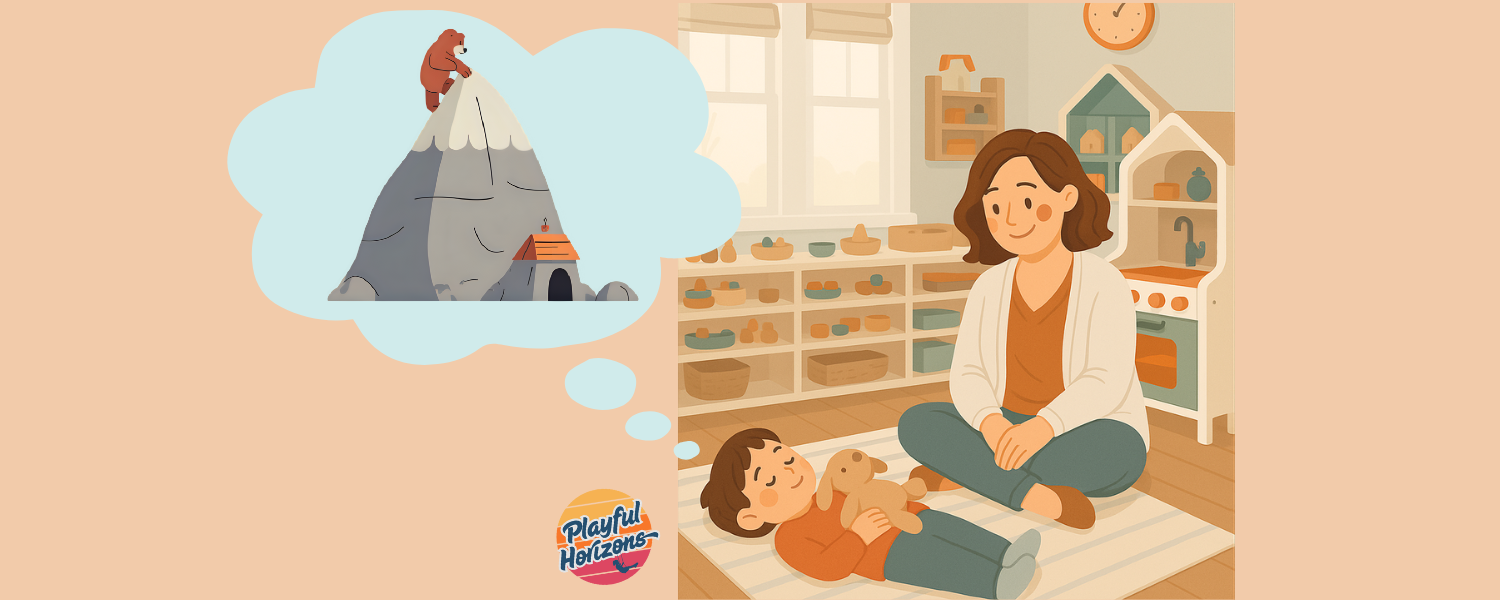Bear on the Mountain: A Mindfulness & Deep Breathing Technique for Kids
* Blog may contain some affiliate links. That means I may earn a small commission (at no extra cost to you) if you choose to buy through them. I only share items I love, trust, or would absolutely use in my own play spaces. Your support helps me keep Playful Horizons running and growing—thank you!
What is “Bear on the Mountain” Breathing?
Imagine a fuzzy little bear making its way up a mountain every time a child takes a deep breath in—and curling into a cozy cave when they breathe out. Bear on the Mountain Breathing transforms basic breath work into a soothing adventure, blending mindfulness, play therapy, and imagination into one snuggly intervention.
This child-friendly strategy is perfect for therapists, teachers, and parents who want to introduce diaphragmatic breathing in a way that sticks—especially for younger children who learn best through movement, story, and sensory play.
How to Guide a Child Through Bear Mountain Breathing
You’ll only need a flat surface and a teddy bear (weighted bears like THIS ONE work beautifully, but any stuffed friend will do!). I use a weighted black bear that wears an orange hoodie!
Step 1: Get Cozy
Invite the child to lie flat on their back—on a carpet, yoga mat, or even their bed. Place the teddy bear on their belly, right over their stomach.
Step 2: Set the Scene
Say something like:
“This teddy bear is ready to climb Bear Mountain! But he needs your help. When you breathe in slowly through your nose, your tummy fills with air like a balloon—and that lifts your bear higher up the mountain!”
Step 3: Climb the Mountain
Guide them to take a slow breath in through their nose while watching the bear rise.
Step 4: Into the Cave
Next, guide them to exhale gently through their mouth and watch the bear slowly go back down—curling up in its little cave to rest.
You can say:
“Shhh, the bear is going to sleep in the cave now. Let’s help it get super comfy and calm.”
Repeat this process 4–5 times, depending on the child’s engagement and need.
Why It Works
Teaches Diaphragmatic Breathing: Watching the bear rise and fall gives children a visual cue for belly breathing—one of the most effective ways to reduce stress.
Engages the Imagination: Children enter a gentle world of storytelling, where they’re helping someone else (the bear), which increases their motivation and attention.
Encourages Self-Regulation: With practice, this becomes a tool children can use to calm themselves in real time—at home, at school, or in session.
Soothes the Nervous System: The physical pressure of the bear can also mimic deep pressure input, which helps regulate the sensory system and promote a sense of safety.
When to Use Bear Mountain Breathing
In Play Therapy Sessions – As a regulation tool before or after intense emotional work or when teaching emotional regulation or coping skills
At Home – During bedtime routines or after meltdowns, practice it often so it becomes second nature
In the Classroom – As part of a calm corner or mindfulness break
In Small Groups – For social-emotional learning or anxiety support
Tips to Make it Even More Fun
Let the child name their bear and give it a personality (e.g., “Mr. Fluff loves warm caves and slow breaths.”)
Add a small blanket or cave prop under the child’s legs to deepen the imaginative play. (This camping themed blanket is such a cute option!)
Play gentle background music or bear-themed nature sounds (like soft wind or forest birds) to help deepen the calm.
Inspired by Mindfulness + Play Therapy
Bear on the Mountain Breathing is rooted in the mindfulness techniques we love from resources like Mindful Schools and supported by the emotional regulation principles found in The Association for Play Therapy. It’s a gentle, developmentally appropriate way to help children connect to their bodies and emotions—one breath at a time.
Ready to Try It?
CLICK HERE to download your free printable visual guide!
Want more imaginative breathing techniques, printable guides, and playful resources for your therapy space or home? Subscribe to the Playful Horizons Newsletter or browse our blog for more inspiration.
And don’t forget—when your child feels like they’re climbing a mountain of big feelings, you can always help them come back down... with a bear and a breath.

